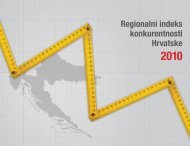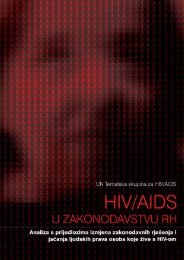WEB engleska verzija end.indd - UNDP Croatia
WEB engleska verzija end.indd - UNDP Croatia
WEB engleska verzija end.indd - UNDP Croatia
- No tags were found...
You also want an ePaper? Increase the reach of your titles
YUMPU automatically turns print PDFs into web optimized ePapers that Google loves.
THE SOCIALLY EXCLUDEDCHAPTER 3- A lack of structured programmes for drug recoveryin penitentiaries and prisons in <strong>Croatia</strong> as well asmandatory programmes for drug users once theyleave the prison.- Hospital detoxification programmes in psychiatricdepartments of town or county hospitals aretoo low in number, forcing many people to behospitalised unnecessarily. However, as thedetoxification of drug users can be organisedwithin the departments for intensive psychiatriccare of any county hospital, further expansion ofhospital capacity is unnecessary.Inexpensive, wide-scope therapy systems outsidehospitals are needed, such as day hospitals for drugusers, groups for psychological rehabilitation andre-socialisation, and methadone treatment programmes.A network of Clubs of Treated Drug usersare also needed, similar to the active network of Clubsof Treated Alcoholics that has been in existence fordecades. The prevention and treatment programmesfor drug users which operate at quite a satisfactorylevel in <strong>Croatia</strong> include:- Therapeutic communities for drug users which,although lacking in number and capacity, aresuccessfully targeting parents of drug users andinstitutions, but at the same time are less attractivefor drug users. In <strong>Croatia</strong>, there are 12 therapycommunities with 33 therapy homes. At themoment, there are slightly more than 1,000 <strong>Croatia</strong>ndrug users in various communes in <strong>Croatia</strong>, Italyand Spain. Most of the communities do not havethe capacity to provide long-term care for girls andwomen. Special therapy homes for female drugusers exist in only three communities, with a totalcapacity for only 48 female drug users.- County centres for the prevention and treatmentof dep<strong>end</strong>ency outside hospitals. Twenty-twocentres for the prevention of dep<strong>end</strong>ency havebeen formed within county public health institutesin all major towns. Considering that a number ofcounties do not have pronounced problems withthe abuse of illegal drugs, the number of suchcentres is unnecessarily high.3.15.3 Access to EducationAbusers of alcohol and psychoactive drugsAt the national level, School Prevention Programmes(SPP) make efforts to reduce the interest of school-agedchildren in experimenting with both illegal and legaldrugs (such as alcohol and nicotine). The programmesalso try to reduce the exclusion of young people whohave problems with drug and alcohol consumptionthrough discreet protection programmes. However,the SPP does not manage to help young people withhigh-risk behaviour (behavioural disorders, abuse ofdrugs and alcohol, inclination to delinquency), so theyfrequently leave schools. Social protection institutionshave not been successful in providing efficient assistancein preventing their further social marginalization.Most treated drug users have secondary school education(62.9%), but there is a significant number of thosewho have never finished their secondary school educationor who have finished only primary school (32%).Only 3.2% of the total number of treated drug usershave university qualifications.3.15.4 Access to Employment andEmployment ServicesAlcohol abusersIn evaluating the impact of alcohol-induced problemsamongst employees, the situation must be consideredin regard to <strong>Croatia</strong>’s socio-cultural context, in whichalcohol has been a component of work for decades.Employees have historically always been able to drinkat work, and on many occasions employers wouldgive alcoholic drinks to their employees as part oftheir wage. It took decades of preventive efforts andpublic health sensitisation of the public for drinkingto be viewed as predominantly connected with leisure.Employers still tolerate drinking amongst theiremployees; they deny the problem of drinking in theircompany, thus actually providing tacit acceptance.Although employers are obliged by law to interveneif they find that one of their employees has a drinkingproblem, they t<strong>end</strong> not to address or report suchproblems in order to avoid causing them additional125

















